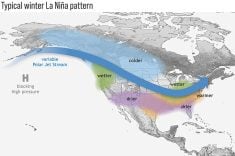The Winnipeg Police Service is hearing favorable comments from the public for arresting six youths aged 13 and 14 for threatening their teachers and classmates, says constable Bob Johnson.
The May 5 arrests were a stern message to students that it is not funny or cool to threaten others, he said. The incidents took place at four Winnipeg schools two weeks ago and included phoning in bomb warnings and threatening to come back with weapons and pipe bombs after arguing with teachers.
“We’d rather err on the side of safety than not,” said Johnson.
Read Also

Canadian Food Inspection Agency extends chronic wasting disease control program consultation deadline
Date extended for consultation period of changes to CWD program
The police action was applauded by Doug McGiffin, president of the Manitoba Association of School Trustees. He said the trustees take such threats seriously.
“I think everyone is taking more seriously the threats” since the incidents at schools in Taber, Alta., and Littleton, Colorado.
“But we are of the mind that Manitoba schools are safe.”
Administrators have been phoning MAST to check on school safety policies and are getting a recommendation to read a Canadian book by Eric Roher called An Educator’s Guide to Violence in Schools. At its May 17 meeting the trustees’ provincial board is studying a report on the potential for violence.
But if a sick individual wants to get into a school, he can, said McGiffin, who suggested one response might be to get teachers to identify kids at risk so they can be counselled.
“I see Littleton and Taber as isolated incidents. … It’s a shame this is the way this was drawn to our attention.”
One province to the west, Doug Willard agrees that such extreme school violence is a rarity. The president of the Saskatchewan Teachers’ Federation said the more common incidents in schools could hardly be called violence. Usually it is a matter of students swearing and pushing each other in hallways.
Unlike the panic that followed the violence in Alberta, Willard said there is less random fear in Saskatchewan. He said we all handle life with a sense of “treating each other properly and obeying the laws,” and if that breaks down, more drastic action may be needed.
Cases of abuse
The 12,000-member STF did a study five years ago examining abuse of teachers. The 936 responses showed 40 percent recalled at least one incident of abuse in the previous year.
The most common form of abuse was verbal, such as insults or name-calling, mainly from students. Property damage, especially at Halloween, was reported by 12 percent of those in the survey.
Abuse involving physical contact was reported by nine percent of the teachers.
“Physical abuse occurred more frequently in cities (69 percent of incidents) and property damage was more prevalent in rural areas (63 percent of incidents),” the report said.
About two-thirds of these incidents were reported and the most common consequences for the students were notification of their parents and temporary suspension.
Teachers in the 1994 survey thought abuse against their profession was increasing and most blamed the media and large class sizes.














